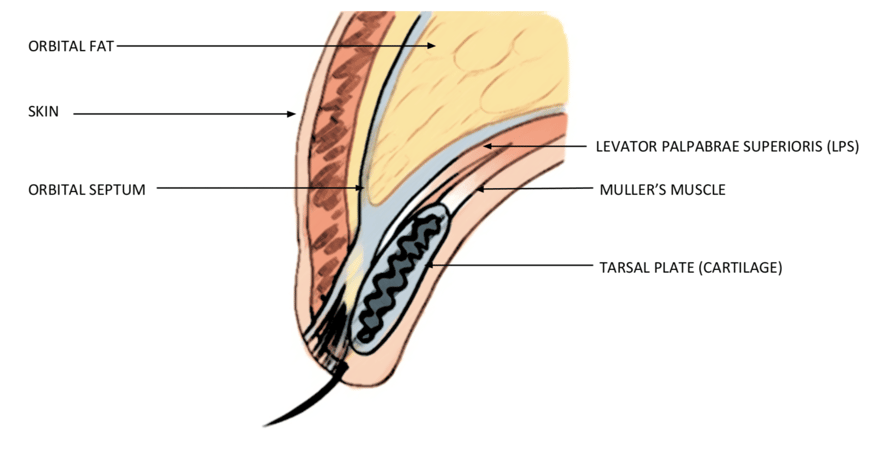Aesthetic Procedures: Brow and Forehead Lift

Table of Contents

Brow And Forehead Lift
Brow Lift (Browpexy) procedure.
The brow and forehead are very underestimated parts of the facial aesthetics. Whilst most people focus on the eyelids, cheeks and jawline in their quest to reverse ageing features, the brow and forehead play an important role in the overall harmonious aesthetic of the face.
The brow and forehead make up the upper third of the face, from the hairline to the eyebrow line. While individual preferences vary, the ideal brow in women should be situated above the bony rim of the eye, with a slight peak at the junctions of the middle and lateral third of the eyebrow, whilst in men, the eyebrow is usually more horizontal. The glabella region situated between the brows as well as the forehead should be smooth in repose yet move naturally with facial expression, whilst the temple region should not be hollow, and the hairline not receded. An additional consideration is the relationship of the eyebrow to the upper eyelid, which needs to be addressed in continuity (see upper eyelid blepharoplasty).

Understanding Brow Lift Procedures:
Brow and forehead lift (also known as browpexy) procedures are performed for multiple reasons. These include:
- Rejuvenating the brow area for a youthful appearance
- Smoothing forehead wrinkles and frown lines
- Elevating sagging brows to open up the eyes
- Creating the arched eyebrow or ‘fox-eye’ look
- Addressing overactive forehead and glabella muscles
- Shortening the elongated forehead
- Enhancing overall facial harmony
There are many ways in which a brow lift can be performed.
-
Minimally invasive procedures
- Less invasive procedures to help reverse brow ptosis include threadlifting and tightening using energy devices. A good example of the latter is radiofrequency energy, either through internal (FaceTite) or external (Morpheus 8) application. In addition, part of the ageing process affects the forehead and temporal fullness. This can be managed using fillers or fat grafting, which will help to produce the volume of youth.
-
Traditional Brow Lift
- A ‘ traditional’ or ‘hairline’ brow lift involves excisions at or in the hairline (coronal incision). This allows direct access to the muscle and fascia of the forehead and allows for safer, long lasting lifting by the anchoring of the deeper muscle and periosteal tissue directly to the bone. Anchoring can be done by devices such as Endotine, or direct suture to fascia and bone. It can also allow for the reduction of overactive forehead muscles, and forehead lowering or lengthening procedures. The drawback is the potential for visible scars and numbness of the scalp. These issues, if correct incision placement is done, are rare.
-
Temporal brow lift
- A temporal brow lift allows for the restoration of the eyebrow arch of youth. It is similar to a traditional brow lift but with shorter scars placed at or in the hairline of the lateral forehead. This allows for even less visible scars and quicker recovery. It is an excellent option for select patients where brow flattening is the main complaint.
-
Endoscopic (Keyhole) Brow Lift:
- The endoscopic browlift is a minimally invasive approach using tiny incisions in the scalp, and a telescopic camera (endoscope) to clearly visualize the structures of the forehead and brow and allow for precise dissection. The entire forehead and brow can be approached in this fashion. Through the small incisions, sutures or hook devices like the Endotine system can be used to lift the brow in the appropriate direction and anchor the deep fascia of the forehead to the bone to give a natural, refreshed appearance.
-
Direct Brow Lift
- A direct brow lift is the excision of skin at and above the eyebrows or at a crease in the forehead. This technique is usually reserved for older patients where scars can be hidden in the forehead creases.
Candidate Assessment
Often, the first sign of brow ptosis is looking tired. The arch of the eyebrow is lost, and the outside of the eyebrow appears lower than the inside. As brow ptosis progresses, it may actually lead to blockage of the upper eyelids laterally, leading to blockage of the visual fields. In these instances, browpexy needs to be performed for improvement of function.
As the brow descends, the muscles of the forehead paradoxically contract to try and help lift the brow from the upper eyelids. This leads to the formation of forehead lines and wrinkles. Initially, they are more prominent at rest, but as time progresses, they can become permanently etched even at rest. Another sign of brow ageing is an elongation of the forehead, which changes the horizontal ratio of the face.
Through personalized consultations with our experienced surgeons, your concerns, expectations and desired outcomes will be discussed. An appropriate treatment plan and approach will be suggested. Sometimes, options may be given based on your ability to tolerate downtime, as well as based on the extent of your brow droopiness. As part of the consult, your overall health and suitability for the procedure will also be evaluated.
The Brow Lift Procedure
Before the actual procedure, you will be given preoperative instructions on how to get yourself ready. The procedure may be performed under local anaesthesia, sedation or general anaesthesia, depending on the extent of the brow lift, the technique used and your ability to tolerate pain. Whatever the method used, measures are in place to ensure a safe and comfortable experience.
Depending on the type of brow lift, incisions are usually in or at the hairline. Very rarely does any hair need to be cut for the procedure. After appropriate dissection to free the attachments to the forehead and brow, various fixation methods are used to lift and shape the brow, anchoring the brow to the bone or periosteum. Excess skin may then be excised, and the surgical incisions closed carefully to reduce any scarring risk.

Recovery and Aftercare
Right after the operation, a pressure dressing is usually applied to the forehead to reduce swelling and bruising and prevent blood clot formation. This dressing is usually removed within the 1st to second post-operative days. Drains are rarely needed. Sutures, if any, are removed at 1 week post-operatively with minimal discomfort. Whilst healing, you can still wash your head and face, with extra care to clean any suture lines and apply antiseptic. The swelling and bruising are usually maximal in the first week, after which it drops off dramatically. Manoeuvres such as cold compress to the forehead and taking arnica can help with reducing this. At 2 weeks post-procedure, about 80-90% of the swelling is gone, and you can return to almost full normal activities.
Risks of the procedure include bleeding, pain, infection, and visible scarring. Though rare, these are all manageable with various interventions in the post-operative recovery period.
Before and After the Brow Lifting Surgery
Patient Expectations:
It is important in your consult with your plastic surgeon to express your desires and expectations such that a treatment plan can be formulated based upon realistic goals and outcomes. Open communication with your surgeon is key to this step, including a thorough examination to determine your suitability. Depending on which procedure you choose, each has its limitations and benefits. Generally, the less invasive a procedure, the less significant lift can be expected. However, with more advanced technology and procedures, there is an increasing shift towards procedures with less scarring and downtime.
Consultation and Planning:
At Polaris Plastic & Reconstructive Surgery, our surgeons are well-trained to perform a comprehensive assessment of your facial anatomy and find the procedures which suit your needs. To help in the consultative process, advanced 3D digital imaging software may be used to simulate the surgical procedure, even coming up with various virtual outcomes to make your choice easier. Most importantly, we are committed to tailoring the surgical plan to meet your unique needs in a warm, safe environment where any concerns or questions you may have can be addressed appropriately.
PATIENT STORIES
Post Massive Weight Loss Body Contouring
A 40-year-old lady consulted with Dr Pek with the desire to correct large amounts of excess skin and soft tissue. She had undergone Bariatric Surgery (Sleeve Gastrectomy) 2 years prior to her presentation and had successfully lost almost 30kg of weight. With ... Read more
Treat Gynecomastia with Minimally Invasive Methods in Singapore
A 38-year-old male engineer presented to Dr Pek with symptomatic growth of his chest/breast area. Since puberty, he complained of unusually prominent chest tissue around his nipple and areolar region. This had worsened gradually over the years, with the left ... Read more
Upper eyelid lift and eyebags rejuvenation
63 years old Chinese female with hypertension and hyperlipidemia presented to Dr Pek with significant droopiness of her upper eyelids on both sides, affecting the upper portion of her visual field. She would constantly feel that her upper eyelids were heavy, ... Read more
Bilateral breast reconstruction using abdominal free flaps
A 45-year-old mother of 2 children was diagnosed with left breast cancer, for which a skin-sparing mastectomy (total removal of breast tissue leaving behind the skin envelope) was recommended. Read more
ARTICLES
TL;DR: A tummy tuck (abdominoplasty) goes beyond aesthetics ...
TL;DR: Lymphedema is long-term swelling caused by poor ...
Contact Form
1 Orchard Boulevard #10-08 Camden Medical Centre, Singapore 248649
6 Napier Rd, #08-01 Gleneagles Medical Center, Singapore 258499
Tel: +65 6737 4565 | Mobile: +65 8828 4565 | Email: clinic@polarisplasticsurgery.com | Business Hours: Mon - Fri: 9am - 6pm | Sat: 9am - 1pm | Sun/Ph: Closed











